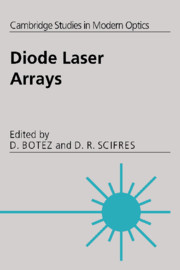Book contents
- Frontmatter
- Contents
- List of contributors
- Preface
- 1 Monolithic phase-locked semiconductor laser arrays
- 2 High-power coherent, semiconductor laser, master oscillator power amplifiers and amplifier arrays
- 3 Microoptical components applied to incoherent and coherent laser arrays
- 4 Modeling of diode laser arrays
- 5 Dynamics of coherent semiconductor laser arrays
- 6 High-average-power semiconductor laser arrays and laser array packaging with an emphasis on pumping solid state lasers
- 7 High-power diode laser arrays and their reliability
- 8 Strained layer quantum well heterostructure laser arrays
- 9 Vertical cavity surface-emitting laser arrays
- 10 Individually addressed arrays of diode lasers
- Index
2 - High-power coherent, semiconductor laser, master oscillator power amplifiers and amplifier arrays
Published online by Cambridge University Press: 10 November 2009
- Frontmatter
- Contents
- List of contributors
- Preface
- 1 Monolithic phase-locked semiconductor laser arrays
- 2 High-power coherent, semiconductor laser, master oscillator power amplifiers and amplifier arrays
- 3 Microoptical components applied to incoherent and coherent laser arrays
- 4 Modeling of diode laser arrays
- 5 Dynamics of coherent semiconductor laser arrays
- 6 High-average-power semiconductor laser arrays and laser array packaging with an emphasis on pumping solid state lasers
- 7 High-power diode laser arrays and their reliability
- 8 Strained layer quantum well heterostructure laser arrays
- 9 Vertical cavity surface-emitting laser arrays
- 10 Individually addressed arrays of diode lasers
- Index
Summary
Introduction
Semiconductor optical sources exhibit several distinct advantages relative to other solid-state and gas laser systems including compact size, high efficiency, high reliability, robustness and manufacturability. As a result, many of the rapidly growing commercial and consumer markets, including telecommunications, printing and optical data storage, have only been realized through the introduction of semiconductor lasers. The next generation of high-performance electronics will require higher-power semiconductor lasers; but as recently as 1992, commercially available high-power (greater than 200 mW cw) semiconductor lasers did not operate in a single spatial mode and therefore did not radiate in a single diffraction-limited lobe. However, the latest advances in the design and fabrication of semiconductor lasers have resulted in the development of high-power diffraction-limited laser sources.
The architectures that have been studied for high-power diffraction-limited semiconductor lasers can be divided into three categories: oscillators, injection-locked oscillators, and master oscillator power amplifiers (MOPAs). The highest-power diffraction-limited operation from oscillators has been demonstrated from antiguided laser arrays. These devices have demonstrated up to 0.5 W cw and 1.5 to 2.0 W pulsed in a diffraction-limited radiation pattern. Disadvantages of antiguide oscillators are their multi-longitudinal-mode spectra and multi-lobed far-field patterns. Another promising oscillator configuration is the broad-area ring oscillator, which has demonstrated single-frequency operation to greater than 1 W pulsed, and diffraction-limited single-lobed operation to approximately 0.5 W pulsed.
- Type
- Chapter
- Information
- Diode Laser Arrays , pp. 72 - 122Publisher: Cambridge University PressPrint publication year: 1994
- 4
- Cited by



